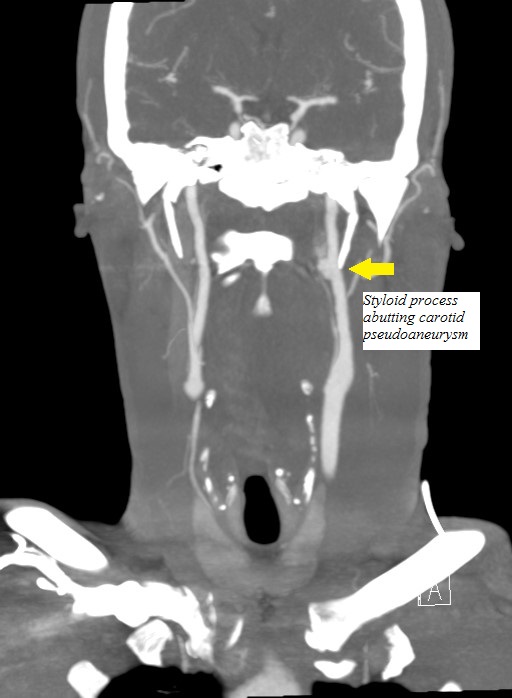Back to 2016 Annual Symposium ePosters
The Presentation and Management of Eagle Syndrome Occurring after Blunt Trauma
Ashley Mann, MD, Chalmers Wood, DDS, MD, Scott Hardouin, MD, Robert Carter, MD, Karl Stark, MD, Scott Kujath, MD, Mark Friedell, MD.
University of Missouri Kansas City, Kansas City, MO, USA.
Background: Eagle Syndrome or Styloid-Carotid Syndrome is unfamiliar to most vascular surgeons. Patients develop neck or neurologic symptoms arising from an elongated styloid process causing pressure or injury to the adjacent carotid artery. Presentations can vary from cervical pain and dysphagia to transient ischemic attacks and stroke.
Methods: We identified two patients over a six year period with Eagle Syndrome due to styloid process injury to the internal carotid artery.
Results: A 29 year old woman sustained multiple severe injuries during a motor vehicle crash in 2009, including an internal carotid artery dissection presumed to be due to a styloid process which was fractured. She suffered an ischemic stroke during her hospitalization. After completing rehabilitation, a subsequent CT arteriogram revealed a 90% internal carotid artery stenosis at the site of her dissection flap. She underwent placement of a bare metal stent in the carotid artery with full resolution of her stenosis. The styloid process was not removed since it was fractured and no longer a possible source of injury. A 38 year old man was evaluated in the emergency department in 2015 for a scalp laceration following an assault. Prior to discharge he developed acute neck pain and dysphagia. A CT arteriogram of the neck revealed an internal carotid artery pseudoaneurysm with an elongated styloid process abutting the artery. He underwent emergent endovascular covered stent placement with complete exclusion of the aneurysm and resolution of his symptoms. The plan is for surgical removal of the styloid process.
Conclusion: Eagle Syndrome should be a consideration in any patient with a carotid injury due to blunt trauma. Carotid stenting and removal of an intact styloid process is an effective treatment modality.

Back to 2016 Annual Symposium ePosters
|







